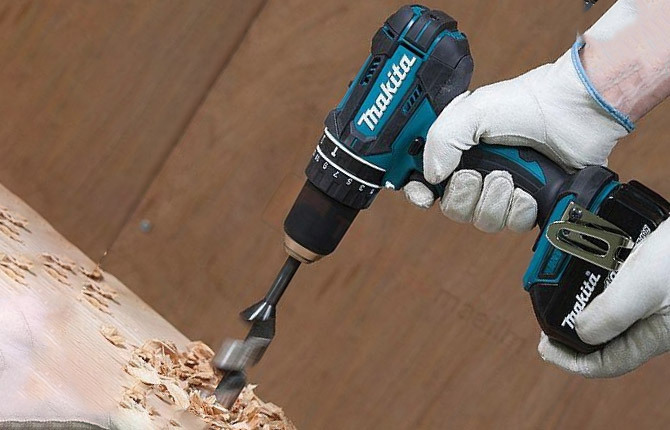When carrying out renovations in the house, you may need a file. Its purpose is grinding and eliminating uneven surfaces. Such a tool is necessary when working with metal, plastic, glass, and wooden objects. You can give the ideal shape to different objects if you have these hand tools in your home. The files are easy to use; not only an experienced repairman, but also a non-professional can perform the processing.
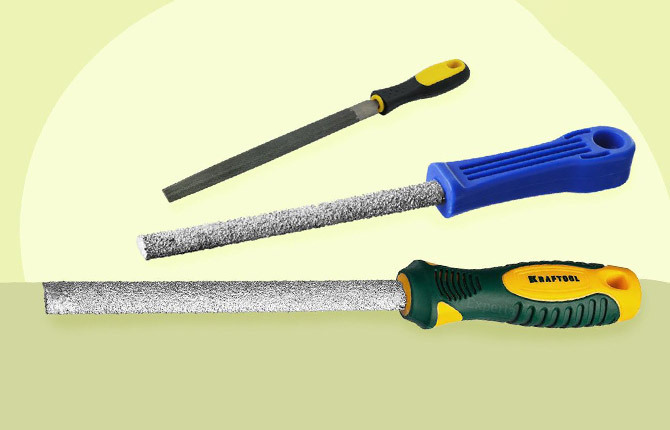
The content of the article:
-
How to choose a file
- Purpose
- Section shape
- Type of cut
- Grain
- Pen
-
File rating
- The best flat files
- Best round files
- The best triangular files
How to choose a file
This tool is made from structural carbon steel, classified U10A-U13A, or from an alloy alloy. The file is needed in order to:
- carry out final processing of the item after rough filing;
- change the size and shape of parts;
- cut out recesses, rounded recesses, oblong channels;
- cut off rough parts from metal or wood, shorten the part;
- sharpen sawing tools.
Before purchasing this hand tool, you should find out what types of files there are, what features they have, and also understand what materials are needed for processing.
General nuances that are worth paying attention to:
- the notch is clear and visible;
- the cutting area has the same shade along its entire length;
- the handle sits firmly on the work surface;
- applied, the manufacturer's label is clearly visible.
Purpose
There are different types. Some should be used to sharpen chainsaw chains, others should be used to process wood, and others are intended for filing hacksaws. The purpose depends on the shape of the section, the hardness of the alloy, and the type of notches. According to the last parameter, a file can be of several types:
- Drachevy. Treat large areas. A brute file can be used to cut down layers over 0.25 mm in thickness. The processing result will be rough; in the future, the part will need to be sanded with another type of file.
- Private. This way you can process the part more accurately. You need to use a personal rasp after the first type of tool. A small layer of metal is removed with a file. In addition, with such equipment you can cut out precise holes according to pre-calculated dimensions.
- Velvet. They perform the final processing of the item. Files away remaining roughness, giving the part smoothness and completeness. If you touch an object after processing with a velvet file, your fingers will not feel any nicks, roughness or unevenness. Files with velvet or personal notches should not be used when working with non-ferrous metals. After a short time, the notch will become clogged with chips and productivity will decrease.
There are also coarse-grained and fine-grained models. The former are designed for quick but rough processing. Harder tools are designed for working on hardened iron and alloys of refractory metals. With a low level of hardness, they are suitable for working with other materials.
Section shape
This parameter divides files into the following types.
| Form | Characteristic |
| flat | for flat, convex parts on the outside, flat parts on the inside |
| square | for square or rectangular holes |
| triangular | for processing corners from the inside of an object |
| semicircle | for concave objects |
| circle | for processing holes, rounded recesses |
| rhombus | for corners, inclined objects |
Type of cut
This parameter shows which layer of metal can be removed with a particular file. The type of notch is determined by the size of the notches, teeth, and the number of teeth per 1 cm.
The drachevy has up to 13 teeth per 1 cm. For personal - 13-25. Velvet teeth fit from 25 to 80 teeth per 1 cm.
Each type is classified by size. Experienced craftsmen know that:
- 1 is pugnacious;
- 2 - personal;
- 3-6 - velvet.
In addition to the frequency of the teeth, the notch has another classification. It can be single or double, as well as point, cross, arc.
Notches of the first type are used to remove layers from light metals, wood, and plastic objects. A double-notch file can handle filing faster and more thoroughly.
Dot notching is used when working with light metals, wood, rubber, and leather. Cross cut is intended for processing steel and cast iron parts. An arc cut file can be used to process soft metals.
Grain
Another feature of a hand tool that plays a role when choosing files. Grit refers to the size of the crushed particles applied to the surface. The more particles there are per 1 cm2, the smaller they are. The tool with the smallest abrasive particles can achieve the smoothest surface of the workpiece.
If you do not need to make a smooth part, and the surface to be processed is large, you can use a file with a small grain size. With increasing demands on the smoothness of the part, it is necessary to select a tool with the largest number of crushed particles on the surface.
In addition, the choice of grain size depends on the material over which the blade will move. A high-grit file can handle a metal surface, and a medium or low-grit file can handle a wooden surface. This requirement is explained by the fact that during friction the material heats up and reacts differently to the impact.
Pen
There are files that are a solid metal sheet. But with regular use, for example, for professional purposes, the presence of a handle makes the tool more convenient. It must meet ergonomic requirements; such equipment must be comfortable to hold in your hand. Hands and arms in general should not get tired quickly during painstaking work.
The file handle can be made of wood, plastic, rubber or polyurethane. Domestic manufacturers equip such instruments with wooden handles. Their disadvantage is that the material can crumble, crack, or dry out.
An alternative to wood is plastic. This material is moisture-resistant, inexpensive, and can be washed. However, such a handle may slip out of your hands, because of this the processing speed may decrease. Recently, manufacturers have been combining file handle materials. A rubber strip is inserted from the outside. They do not slip out and are comfortable for processing.
File rating
Each owner has more than one file in his drawer. This tool for manual processing of objects and surfaces may be needed in a variety of situations. They can be used to remove old paint from a gate, clean rust from metal parts, sharpen a hacksaw or chainsaw tip.
In order for the processing to be performed efficiently, you need to be able to choose the type of tool for each specific job. It is recommended to have several designed to perform different tasks. A review of files for metal and other materials is presented in the material.
The best flat files
The working surface of such files implies their use on flat areas. Flat objects can be wooden, metal, cast iron, or plastic. You can work with flat tools after a mechanic or turner has processed any part. Flat ones can have simple, cross, arc, or rasp notches. Flat material of varying density and hardness can be filed with a flat tool.
Kraftool 16080-20_z01
Price: 871 rub.
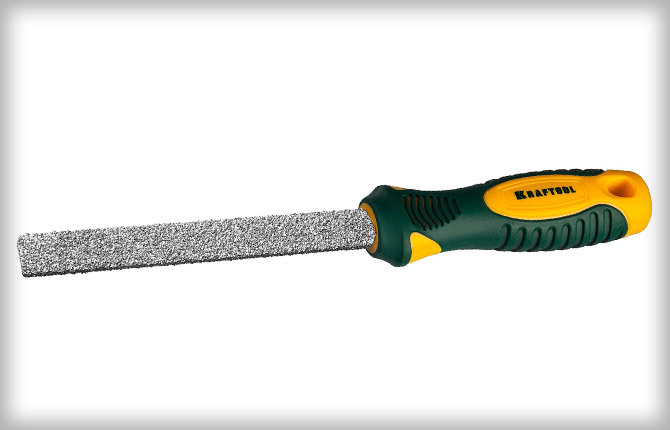
The ranking of the best files opens with a German tool. Each of the two sides has its own grain size. With one tool you can first rough the surface and then sand it clean. The durable alloy of the granular coating is close in strength to diamond. The grain is applied automatically. This increases the strength of the tool. Based on tungsten, carbide. The handle has a relief structure and an emphasis. Such a tool will not slip out of your hand and will hold securely in your palm. Craftul can be used for working on wood and metal, ceramics and plastic.
Pros:
- 25 mm wide allows you to quickly file large surfaces;
- ergonomic plastic handle has a rubberized coating;
- Can be hung on a nail for storage;
- The size allows you to work for a long time without interruption.
Minuses:
- the side with large grains does not go well on hard material, it is better to use for loose surfaces;
- Expensive.
Cobalt 247-835
Price: 147 rub.
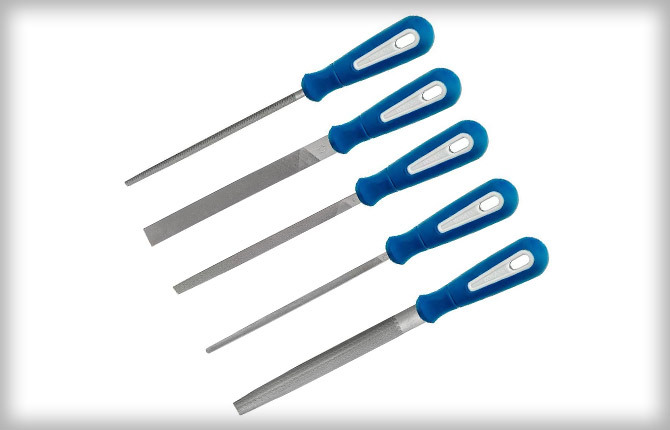
This hand file is designed for metal work. The dimensions of the part can be of any size. Cobalt will cope perfectly with its function. The needle file is made in Russia and fully meets the requirements for equipment of this type. Notch No. 1 can be used for both sharpening and surface grinding. The handle with a rubber insert is ergonomic, processing is quick and the joints of the hands are not strained. Length - 14 cm.
Pros:
- sold in a set with a file 16 cm long;
- does not slip out of the hand;
- affordable price;
- weighs 40 g.
Minuses:
- The handle may bend if you press too hard.
FIT 42576
Price: 286 rub.

This representative of the rating is produced in China, but the owner of the equipment is a Canadian company. The sharpening tool meets all standards and international requirements. FIT 42576 is made of high carbon iron. This material has increased hardness, it is resistant to moisture, dirt, and does not rust. The type of notch is personal. You can quickly and accurately process the desired part.
The file can be used regularly to process surfaces for a long time. It is comfortable to hold such a rasp in your hands; you can work without straining your hands. The model is one of the best among metal files.
Pros:
- two-component handle with comfortable grip;
- relief surface in front of the stop;
- lasting.
Minuses:
- After a few months it may become rusty.
Best round files
Files with a round cross-section are used to process the internal surfaces of holes to the required size and grind the concave surface. Round ones can be used on aluminum, iron, and copper objects. They can be coarse-grained, fine-grained, and are intended for both rough processing and final grinding. Round files are available in carpentry and plumbing workshops. The best files are presented below.
Vira 820004
Price: 366 rub.
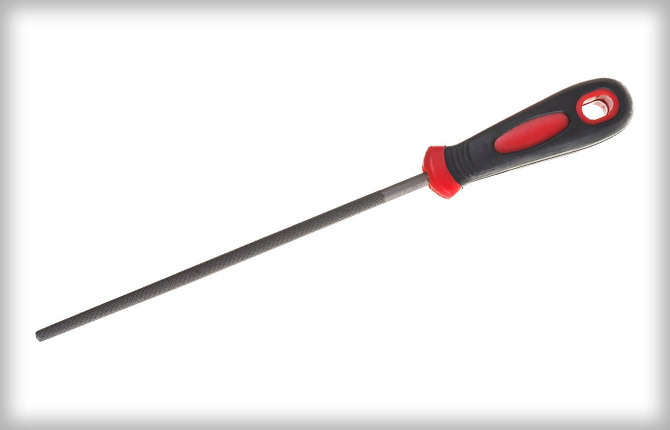
This model from a Russian manufacturer has a length of 200 mm. This size is universal and allows you to easily handle the tool. The Vira 820004 file can be used to process rounded recesses of various diameters.
Strong, made of high-strength steel, which does not contain alloying additives. This material is hard, durable, and resistant to self-destruction. The personal type of notch allows you to give smoothness to wooden, metal, and plastic parts. The handle with a rubber element does not slip and ensures quick handling.
Pros:
- 13 teeth per cm2;
- convenient stop;
- can be hung on a nail;
- the handle is firmly connected to the main part.
Minuses:
- The rubber on the handle wears off quickly.
"Sparta" 158255
Price: 270 rub.
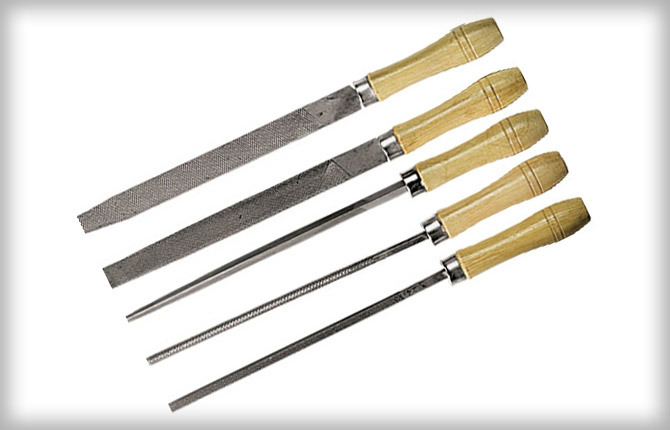
This rasp is intended for finishing. They can work with hardened steel, ceramics, glass, and graphite. The manufacturer has assembled a set of diamond finishing tools. Complete with a flat file they sell semicircular, triangular, oval, knife, round, square, double semicircular. Length - 16 cm.
Pros:
- 10 pieces at once included;
- the price is great;
- storage case;
- cut smoothly.
Minuses:
- uncomfortable to hold;
- the handle may come off.
Bison Profi 33367-150-5
Price: 445 rub.
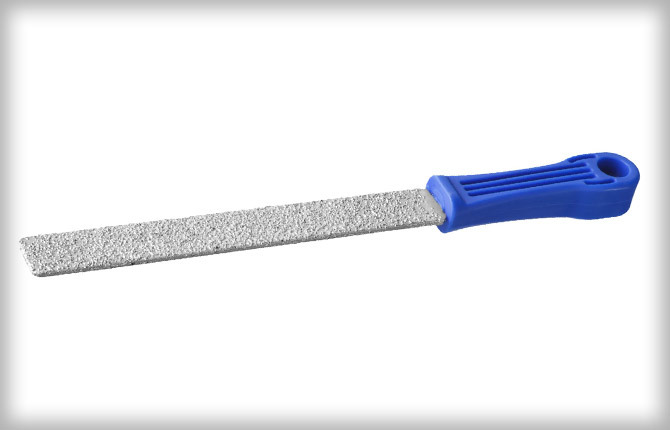
This round file is made of a special alloy for sharpening tools. It is based on a mixture of tungsten and carbide, which improves performance. Automatic grit placement ensures increased tool productivity. You can file wood and plastic objects. Bison Profi can also handle the processing of cast iron and aluminum. The tool is not long (15 cm), so it can be used in a cramped workshop. Medium-frequency grains are evenly distributed throughout the entire working plane, so processing is carried out carefully and evenly.
Pros:
- handle material: impact-resistant plastic;
- the stop prevents slipping;
- there is a hole for hanging;
- carefully handles ceramic objects.
Minuses:
- the handle is short;
- overpriced.
The best triangular files
Tools with a triangular cross-section are most often used in carpentry, plumbing and installation work. With such a file you can make a recess into parts and process the internal parts of objects. A trihedron is suitable for chains, shovels, knives, and sharpening other tools. The most productive models are presented in the review below.
Ermak 645-008
Price: 184 rub.
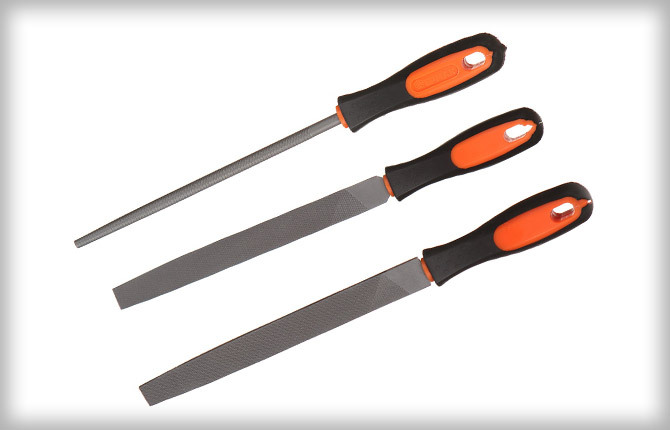
To manufacture this model, carbon steel is used for the production of tools. This material will last for several years, will not wear off, and will not rust. The needle file has a special type of notches and is intended for processing objects and parts made of non-ferrous metal, wood, steel, and plastic. The wooden handle is securely connected to the main part of the tool.
Pros:
- does not scratch the surface of objects;
- you can sharpen a hacksaw;
- the wooden handle is fastened with an iron ring for fixation;
- there is a thumb rest;
- standard length.
Minuses:
- the handle becomes loose from constant loads;
- wears off quickly.
TUNDRA
Price: 112 rub.
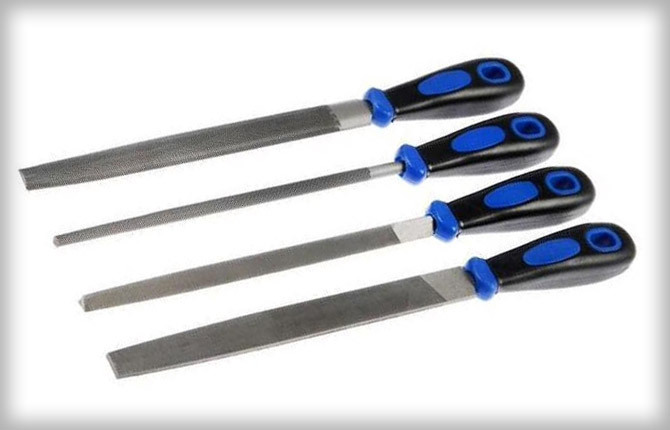
This triangular hand rasp is indispensable in a private home in the countryside. Tundra is a file for a 15 cm long saw chain. This model does not have a rubber, plastic or wooden handle, so there is no possibility of this part becoming loose or breaking. The Tundra model is produced in China and meets all necessary standards.
Pros:
- adequate price;
- solid metal product;
- impossible to break;
- you can buy 10 pcs. packaged.
Minuses:
- no handle;
- Designed for chains only.
Cobalt 247-415
Price: 231 rub.
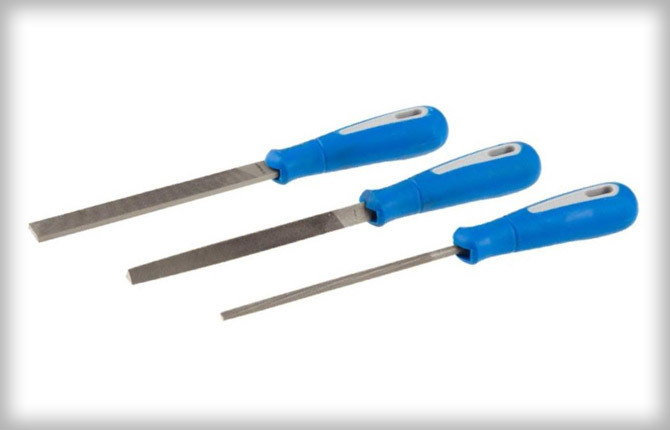
This trihedron is made from durable, special tool steel. The raw materials are durable and have anti-corrosion properties. The type of cut is personal, allowing you to achieve smooth, accurate grinding of parts without leaving scratches. A file can be used to process objects made of non-ferrous metals, wood, non-hardened steel, and plastic. The manufacturer uses reinforced plastic for the handle. The handle is embossed, made in the shape of a human palm.
Pros:
- you can sharpen hacksaws;
- a stop is provided;
- withstands constant load.
Minuses:
- the handle may come off;
- If you press too hard, it may scratch the object.
Choosing a file will not be difficult if you know the parameters by which such equipment must be selected. Tools with different sections and grain sizes should be in the house of a caring, businesslike owner. Suddenly you need to correct, file or sharpen a part/object.
What type of files do you prefer to use and why? Share the link on social networks and bookmark the article.

